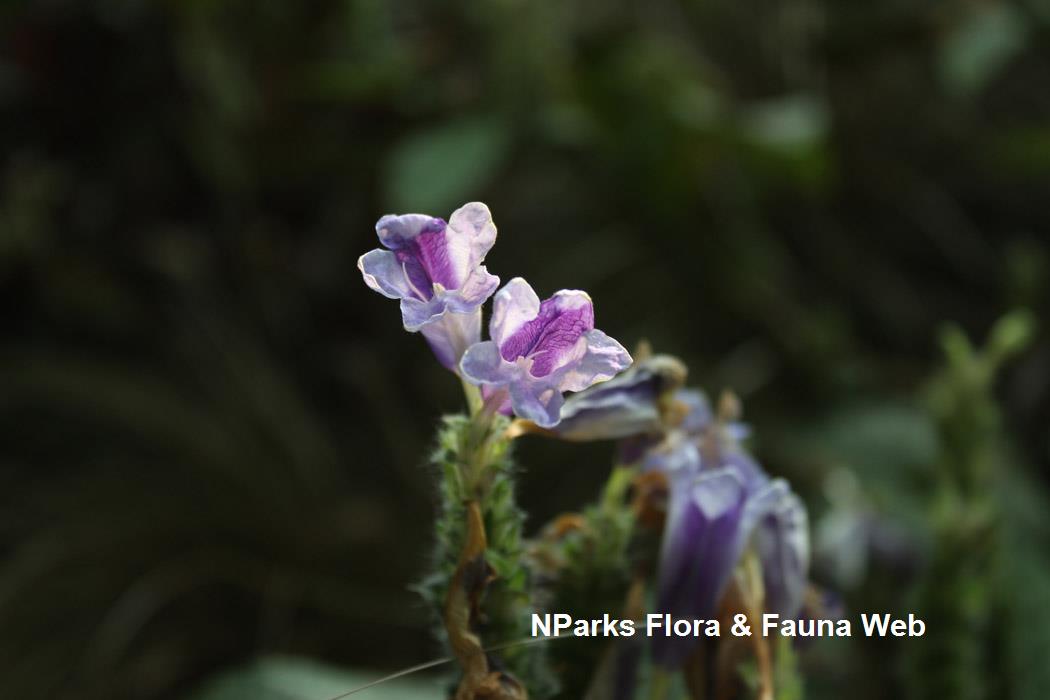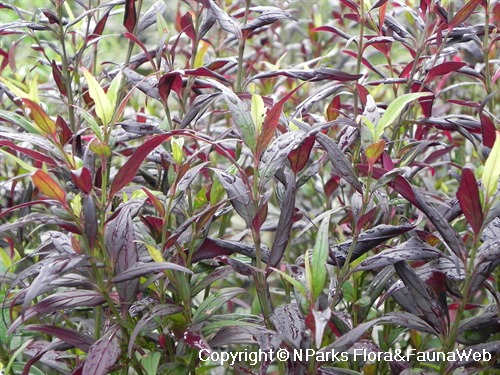
Back
Strobilanthes auriculata var. dyeriana (Mast.) J.R.I.Wood
| Family Name: | Acanthaceae |
| Synonyms: | Strobilanthes dyeriana Mast., Perilepta dyeriana (Mast.) Bremek. |
| Common Name: | Persian Shield, Burma Conehead |
Persian Shield (Strobilanthes auriculata var. dyeriana) is a striking ornamental shrub that grows up to 1.2 m tall. It has variegated purple-green leaves with metallic silver streaks that create a dramatic shimmering effect under light. It performs best in bright, indirect light on well-drained soil, and is ideal for shady gardens or indoor spaces. It complements other foliage plants and adds vivid colour contrast.
Name
Classifications and Characteristics
| Plant Division | Angiosperms (Flowering Seed Plants) (Dicotyledon) |
|---|---|
| Plant Growth Form | Shrub |
| Lifespan (in Singapore) | Perennial |
| Mode of Nutrition | Autotrophic |
| Plant Shape | Shrubby |
| Maximum Height | 0.9 m to 1.2 m |
| Maximum Plant Spread / Crown Width | 0.6 m to 0.9 m |
Biogeography
| Native Distribution | Myanmar |
|---|---|
| Native Habitat | Terrestrial |
| Preferred Climate Zone | Sub-Tropical / Monsoonal, Tropical |
| Local Conservation Status | Non-native |
Description and Ethnobotany
| Growth Form | Erect herbaceous plant, with maximum height from 0.9 m to 1.2 m tall and maximum spread from 0.6 m - 0.9 m wide. |
|---|---|
| Foliage | Leaves variegated with shimmering shades of purple, green and silver, with completely purple underneath, ovate-lanceolate in shape and measuring up to 20 cm long. |
| Stems | Stems are squarish in cross-section. |
| Flowers | Purple, 5-lobed funnel-shaped flowers are arranged in short cone-like infloresences. In its native range, this species flowers during fall and winter. |
| Associated Fauna | Grey Pansy (Junonia atlites) |
| Cultivation | Plant grows best in bright light with no direct sunlight, on rich, fertile, well-drained soil. Tip-prune to promote bushy growth and minimize legginess. |
| Etymology | Genus Strobilanthes is derived from two Greek words - "strobilos" which means cone and "anthos" which means flower, and refers to the plant's inflorescence. Species epithet auriculata means lobed like an ear, which refers to the flower petal shape. Variety dyerianus is named after Sir William Thistleton-Dyer (1843 - 1928) of the Science Schools Building, London. |
Landscaping Features
| Landscaping | The plant is ideal for shady gardens or indoor spaces, for its ornamental leaves; purple-green with metallic silver streaks. |
|---|---|
| Desirable Plant Features | Ornamental Foliage, Ornamental Flowers |
| Landscape Uses | Container Planting, General, Parks & Gardens, Small Gardens |
| Thematic Landscaping | Naturalistic Garden |
Fauna, Pollination and Dispersal
| Fauna Pollination Dispersal Associated Fauna | Butterfly Host Plant (Associated with: Junonia atlites) |
|---|
Plant Care and Propagation
| Light Preference | Semi-Shade |
|---|---|
| Water Preference | Moderate Water |
| Plant Growth Rate | Moderate |
| Rootzone Tolerance | Fertile Loamy Soils, Well-Drained Soils |
| Diseases | Spider mites (esp. indoor plants), root rot |
| Propagation Method | Seed, Stem Cutting |
| Maintenance Requirements Remarks | Prune plant to promote bushy growth and reduce legginess. |
Foliar
| Foliage Retention | Evergreen |
|---|---|
| Mature Foliage Colour(s) | Green, Purple, Silver / Grey |
| Mature Foliage Texture(s) | Velvety / Furry / Tomentose, Raised / Sunken Veins |
| Foliar Type | Simple / Unifoliate |
| Foliar Arrangement Along Stem | Opposite |
| Foliar Shape(s) | Non-Palm Foliage (Elliptical) |
| Foliar Venation | Pinnate / Net |
| Foliar Margin | Serrate / Toothed |
| Foliar Apex - Tip | Acuminate |
| Foliar Base | Truncate / Square |
| Typical Foliar Area | Notophyll ( 20.25cm2 - 45 cm2 ), Mesophyll ( 45cm2 - 182.25 cm2 ) |
| Leaf Area Index (LAI) for Green Plot Ratio | 4.5 (Shrub & Groundcover - Dicot) |
Non - Foliar and Storage
| Stem Type & Modification | Herbaceous |
|---|---|
| Root Type | Underground (Fibrous Root) |
Floral (Angiosperm)
| Flower & Plant Sexuality | Bisexual Flowers |
| Flower Colour(s) | Blue, Purple |
|---|---|
| Flower Grouping | Cluster / Inflorescence |
| Individual Flower Shape | Funnelform / Funnel-shaped |
| Flowering Habit | Polycarpic |
Image Repository
Others
| Master ID | 1188 |
|---|---|
| Species ID | 2481 |
| Flora Disclaimer | The information in this website has been compiled from reliable sources, such as reference works on medicinal plants. It is not a substitute for medical advice or treatment and NParks does not purport to provide any medical advice. Readers should always consult his/her physician before using or consuming a plant for medicinal purposes. |











